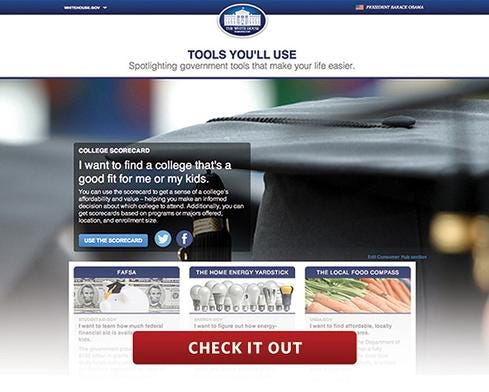WW II Memorial Debuts Connection To The PastWW II Memorial Debuts Connection To The Past
New WiFi-enhanced service at WW II memorial in Washington lets visitors access historical records and other information from interactive kiosks.


5 Online Tools Uncle Sam Wants You To Use
5 Online Tools Uncle Sam Wants You To Use (Click image for larger view and slideshow.)
Visitors to the National Mall's World War II memorial discovered an added dimension to their experience over the Memorial Day weekend: a new interactive service that provides mobile access to historical records, making the WWII memorial the first WiFi-enhanced memorial on the mall.
A newly installed network of WiFi-enabled kiosks gives visitors access to photos and war records drawn from federal archives and databases kept by different agencies, including the National Archives. For instance, a visitor can look up his or her grandfather's service record, search for others who served in his unit, find contemporaneous photos, or read about battles in which he fought.
There are four kiosks at the WW II Memorial and two more being set up at the Korean War Memorial in this first phase of the project. The project was developed by the American Battle Monuments Commission.
"It was important to the American Battle Monuments Commission [to] tell a lot of stories to enrich the visitor experience," says Michael Buie, creative director for INADEV, the contractor that carried out the project. "For example, there is a lot of information about the Tuskegee Airmen, and we wanted to find stories that were really compelling [and] featured key people."
[Veterans Employment Center offers job search tools to help transitioning service members connect with employers. Read White House Website Helps Veterans Find Jobs .]
Buie says working on the content for the interactive kiosks provided some of the most interesting moments in his 20-year career. "[Three of us] went down to the National Archives and went through hundreds and hundreds of photos, many of which hadn't been seen since they were taken. You can imagine how voluminous [the Archives'] content is."
Vikrant Binjrajka, INADEV's chief technology officer, says the kiosks share two onsite servers that have Internet access and that manage the geographically focused wireless network. While the WiFi network was launched Saturday, in time for the 10th anniversary of the National World War II Memorial, it will only be available by using the kiosks at first. A planned second phase would extend WiFi across the entire memorial so visitors can stand inside looking at the pillars and access the kiosks' information on their smartphones or tablets.
The second phase, which is contingent on receiving funding, also would include Web access for people anywhere in the world. "There are many veterans who will not be able to travel to D.C., so we want to enable the experience for them at home," Buie explains.

When the kiosks at the Korean War Memorial are completed, they'll be managed and updated via the cloud, Binjrajka says. The interactive displays will be updated with new features, stories, and database records, so the visitors who used them this weekend, for instance, will find new materials if they come back in future years. Since they form their own little network, the kiosks will continue to work even if the connection to the cloud is lost.
"One of the most important aspects of the kiosks is the People Finder," he says. "We focused heavily on that. A lot of people really want to find their loved ones. There are a number of databases that the [Commission] and other agencies maintain… We identified all of them for access so when people go to search, they can draw on all of them. We will periodically replicate the databases and bring in the most current information."
Another way the records will be enhanced and shared is through the Registry of Remembrance. "People can actually go in and honor their loved ones and the role they played in the war," he says. "We can collect [them] and people can see them. They can post photos, write some notes, and then they will be available [through the kiosks]."
The kiosks comply with government laws for the disabled, Buie says, including voice activation for those with visual impairments.
Binjrajka says the company has had discussions with the Commission about expanding the kiosks and WiFi capabilities to other memorials and monuments. "If the agency had its way, it would happen to every one on the Mall," adds Buie. "They're really focused on trying to get there."
Find out how a government program is putting cloud computing on the fast track to better security. Also in the Cloud Security issue of information Government: Defense CIO Teri Takai on why FedRAMP helps everyone.
About the Author
You May Also Like






